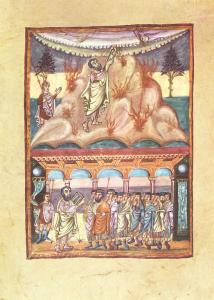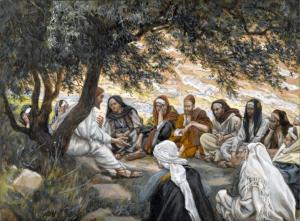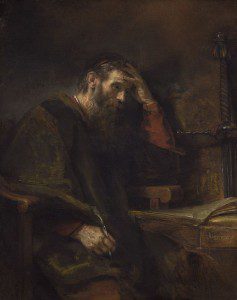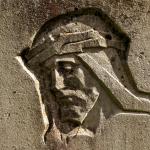 Creeds are not strictly extra-biblical. There are a number of statements within the pages of Scripture. These don’t start with the phrase “I believe” or “we believe” but do represent concise statements of doctrine and belief. The first such statement is found in Deuteronomy 6:4-5.
Creeds are not strictly extra-biblical. There are a number of statements within the pages of Scripture. These don’t start with the phrase “I believe” or “we believe” but do represent concise statements of doctrine and belief. The first such statement is found in Deuteronomy 6:4-5.
Hear, O Israel: The Lord our God, the Lord is one. Love the Lord your God with all your heart and with all your soul and with all your strength
The NIV indicates alternative translations of the first verse here. The Lord our God is one Lord; or The Lord is our God, the Lord is one; or The Lord is our God, the Lord alone. The Shema, as this is called, teaches that the only God for Israel is YHWH and they are to worship no other. Israel is defined as the people of God. It may also teach and has been read as teaching monotheism. The importance is strengthened by verses 6-9 that follow:
These commandments that I give you today are to be on your hearts. Impress them on your children. Talk about them when you sit at home and when you walk along the road, when you lie down and when you get up. Tie them as symbols on your hands and bind them on your foreheads. Write them on the doorframes of your houses and on your gates.
Deuteronomy 6:4-9 and the similar passage in 11:13-21 are in the mezuzah on doors of Jewish houses and apartments today. There was one at the apartment we lived in when on sabbatical in Jerusalem (an excellent teaching moment). Michael Bird ( What Christians ought to Believe: An Introduction to Christian Doctrine Through the Apostles’ Creed) notes that “The Shema described the essential elements of Israel’s faith in a short summary statement.” (p. 18) This is what creeds do.
 Both Jesus and Paul affirmed the Shema. Jesus called it the most important commandment (Mark 12:29) and added the command to love your neighbor as the second most important. Paul alludes to it in a short creedal statement he includes in 1 Corinthians 8:6 when discussing food sacrificed to idols. To belief in one God he adds belief in one Lord. The verse reads like a formula known in the church.
Both Jesus and Paul affirmed the Shema. Jesus called it the most important commandment (Mark 12:29) and added the command to love your neighbor as the second most important. Paul alludes to it in a short creedal statement he includes in 1 Corinthians 8:6 when discussing food sacrificed to idols. To belief in one God he adds belief in one Lord. The verse reads like a formula known in the church.
Yet for us there is but one God, the Father, from whom all things came and for whom we live; and there is but one Lord, Jesus Christ, through whom all things came and through whom we live.
 Paul includes a number of other creed-like statements (concise statements of essential beliefs) in his writing. They seem to reflect the apostolic teaching that eventually led to the rule of faith in the early church.
Paul includes a number of other creed-like statements (concise statements of essential beliefs) in his writing. They seem to reflect the apostolic teaching that eventually led to the rule of faith in the early church.
1 Cor. 15:3-5
For what I received I passed on to you as of first importance: that Christ died for our sins according to the Scriptures, that he was buried, that he was raised on the third day according to the Scriptures, and that he appeared … [to many people]
1 Tim 3:16
Beyond all question, the mystery from which true godliness springs is great:
He appeared in the flesh,
was vindicated by the Spirit,
was seen by angels,
was preached among the nations,
was believed on in the world,
was taken up in glory.
Col. 1:15-20
The Son is the image of the invisible God, the firstborn over all creation. For in him all things were created: things in heaven and on earth, visible and invisible, whether thrones or powers or rulers or authorities; all things have been created through him and for him. He is before all things, and in him all things hold together. And he is the head of the body, the church; he is the beginning and the firstborn from among the dead, so that in everything he might have the supremacy. For God was pleased to have all his fullness dwell in him, and through him to reconcile to himself all things, whether things on earth or things in heaven, by making peace through his blood, shed on the cross.
Phil. 2:5-11
In your relationships with one another, have the same mindset as Christ Jesus:
Who, being in very nature God,
did not consider equality with God something to be used to his own advantage;
rather, he made himself nothing
by taking the very nature of a servant,
being made in human likeness.
And being found in appearance as a man,
he humbled himself
by becoming obedient to death—
even death on a cross!
Therefore God exalted him to the highest place
and gave him the name that is above every name,
that at the name of Jesus every knee should bow,
in heaven and on earth and under the earth,
and every tongue acknowledge that Jesus Christ is Lord,
to the glory of God the Father.
The opening of John’s Gospel might be a similar such statement (John 1:1-5,14):
In the beginning was the Word, and the Word was with God, and the Word was God. He was with God in the beginning. Through him all things were made; without him nothing was made that has been made. In him was life, and that life was the light of all mankind. The light shines in the darkness, and the darkness has not overcome it.
The Word became flesh and made his dwelling among us. We have seen his glory, the glory of the one and only Son, who came from the Father, full of grace and truth.
The New Testament statements focus on the life, death, resurrection, and nature of Jesus Christ our Lord. They affirm God the Father but focus on the Son. (1 Tim 3:16 also brings the Spirit into the mix.) Christ is even connected with God’s act of creation in Col. 1 and John 1.
What other concise, easily remembered statements consistent do you find in Scripture?
What role might these have played in the early church?
If you wish to contact me directly, you may do so at rjs4mail[at]att.net.
If interested you can subscribe to a full text feed of my posts at Musings on Science and Theology.
















